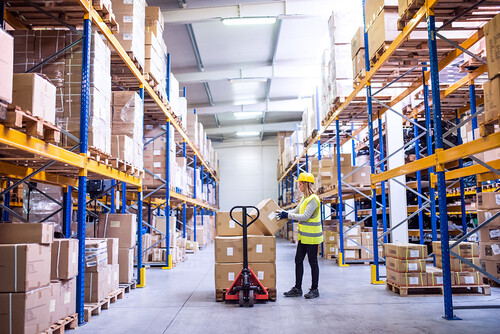How to republish
Read the original article in french and consult terms of republication.
Cities and delivery services: does the “logistics sprawl” increase pollution?
By Antoine Robichet and Patrick Nierat, laboratoire Systèmes Productifs, Logistique, Organisation des Transports, et Travail (SPLOTT),Université Gustave Eiffel

Photo credit Epictura (186973604 Halfpoint)
In the past 30 years, cities have become increasingly spread out. One of the consequences is that logistic facilities (sorting terminals and warehouses) have been moved away from city centre. This phenomenon, known as the logistics sprawl, has been demonstrated for the first time in the Paris urban area.
The phenomenon leads to an increase in the distances travelled - and by extension an increase in pollution - to deliver packages in the city itself. However, the full consequences of this distance-based strategy are still under debate: when the situation is analysed as a whole, with the city and its periphery, the sprawl solution appears sometime to be the optimal choice.
How is demand distributed in space?
If we consider the city centre alone, the logistics sprawl leads to an increase in distances travelled. Logistics facilities are further away from city centres and greater distances must be travelled in order to carry out operations (deliveries and shipments). This leads to an increase in emissions caused by goods transport.
Based on this observation, it would be a good idea to encourage the return of logistics facilities to the heart of cities in order to limit the negative consequences (pollution, congestion, etc.). However, this argument is only valid when the majority of demand is located in the city centre.
If we consider demand in terms of the surrounding area, the balance changes. In the case of Île-de-France, the city of Paris has a much higher population density than the rest of the region (20,544.8 inhabitants per km2 compared with 1,010.9 inhabitants per km2), but the Parisian population only accounts for 18% of the total population of Île-de-France.
While inhabitants are an indicator of flow quantity, we must also consider companies, particularly industrial ones, which are major emitters of goods. This industrial fabric is mainly located on the outskirts of cities, as shown by a study on a parcel service carrier.
“Polycentric” logistics
Another element has to be considered: main transporters do not use a single place for their operations in large regions (such as Île-de-France), but have several terminals, each responsible for a dedicated area.
In a polycentric approach, the regional area is divided into several sub-areas based on a transport-optimisation strategy (which minimises the distance travelled by trucks). When combining the two factors, namely the fact that demand is distributed over the whole region and not concentrated in its centre and the choice of a polycentric organisation, the decision to locate hubs on the periphery seems the obvious choice.
Of course, it cannot be denied that this may not be the only optimal solution for operating in city centres. To avoid improving the situation locally to the detriment of the overall situation, the impact on the whole region (in this case Île-de-France) must be assessed and not just the particular sub-area that is the urban centre (in this case Paris).
Access to land and minimisation of costs
The polycentric approach has other advantages. With access to land becoming increasingly difficult (particularly for large plots in densely built areas), this form of organisation makes it possible to operate from several smaller terminals instead of one large one, with flows distributed between the different centres. In addition, moving away from urban centres offers access to cheaper plots.
Up to this point, the model only takes account of urban logistics without considering the peripheries or interurban routes. But terminals are the link between long distances and the first- or last-miles.
Moving a platform to the heart of an urban centre also means moving long-distance flows that currently stop on the outskirts of cities. As a result, the location and number of terminals optimise the first and last miles as well as long-distance transport with the aim of minimising overall costs.
The end of city-based logistics facilities?
The polycentric, peripheral location strategy is not incompatible with the creation of micro-hubs in city centres, which operate like satellites of the peripheral platforms for local deliveries.
They are also necessary for deliveries by cargo bikes, which have a much shorter range than trucks, and are only directly connected to the peripheral platforms and to all the platforms in the network (at national or international level)..
Lastly, it is not easy to give a single answer to the question of the consequences of the logistics sprawl in terms of pollution or efficiency. On the one hand, demand on the periphery is high in terms of stock but less dense (industries and some individuals), while on the other hand, demand in urban centres is lower in terms of stock but much denser. In response to this, transport operators have implemented strategies such as polycentrism to be able to handle such heterogeneity in demand.
To conclude, it is important to maintain logistics facilities in the hearts of cities, and in particular to set up cycle logistics, which offers a sustainable solution for the decarbonisation of goods transport, a major challenge for the coming decades.
Identity card of the article
| Original title: | Villes et livraisons : le «desserrement logistique» augmente-t-il la pollution ? |
| Authors: | Antoine Robichet and Patrick Nierat |
| Publisher: | The Conversation France |
| Collection: | The Conversation France |
| License: | The original version of the article was published in French by The Conversation France under Creative Commons license. Read the original article. An English version was created by Hancock & Hutton for Université Gustave Eiffel and was published by Reflexscience under the same license. |
| Date: | March 27, 2023 |
| Languages: | English and french |
| Keywords: | pollution, road transport, logistics, e-commerce, city centre, delivery, supply chains |

![[Translate to English:] Licence creative commons BY-SA 4.0 [Translate to English:] Licence creative commons BY-SA 4.0](https://reflexscience.univ-gustave-eiffel.fr/fileadmin/ReflexScience/Accueil/Logos/CCbySA.png)